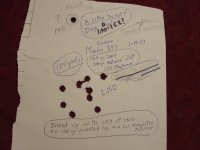I've been reloading for 45 years, but recently inherited my father's reloading equipment. Among the items is a 1987 Speer Reloading Manual #11.
This manual lists .357 Magnum loads with a 158g jacketed bullet with a range of 13.9 to 15.9 grains of 2400. My Speer Manual #12 (published 1994) shows the 2400 powder range for the same bullet between 11.2 to 12.5 grains.
That's a big difference - if I use the 1987 data, the starting load (13.9) exceeds the maximum load (12.5) in the 1994 book. I'm a careful reloader and get nervous exceeding any published maximum load, but 12.5g of 2400 behind a 158g seems to be a pretty mild .357 load.
I would appreciate comments from you who have experience with 2400 in the .357 Magnum.
This manual lists .357 Magnum loads with a 158g jacketed bullet with a range of 13.9 to 15.9 grains of 2400. My Speer Manual #12 (published 1994) shows the 2400 powder range for the same bullet between 11.2 to 12.5 grains.
That's a big difference - if I use the 1987 data, the starting load (13.9) exceeds the maximum load (12.5) in the 1994 book. I'm a careful reloader and get nervous exceeding any published maximum load, but 12.5g of 2400 behind a 158g seems to be a pretty mild .357 load.
I would appreciate comments from you who have experience with 2400 in the .357 Magnum.

